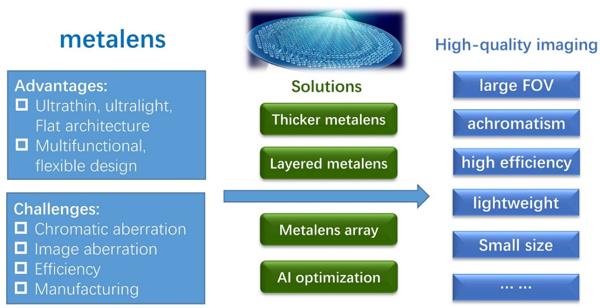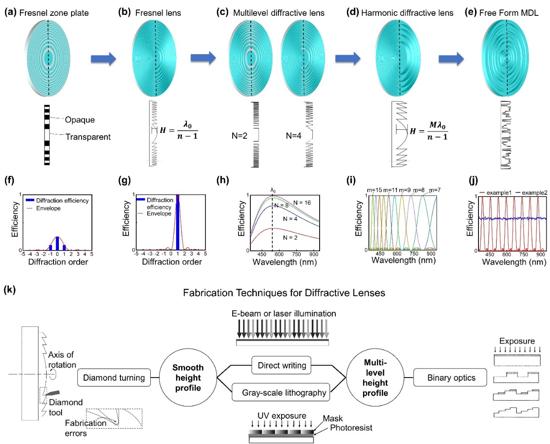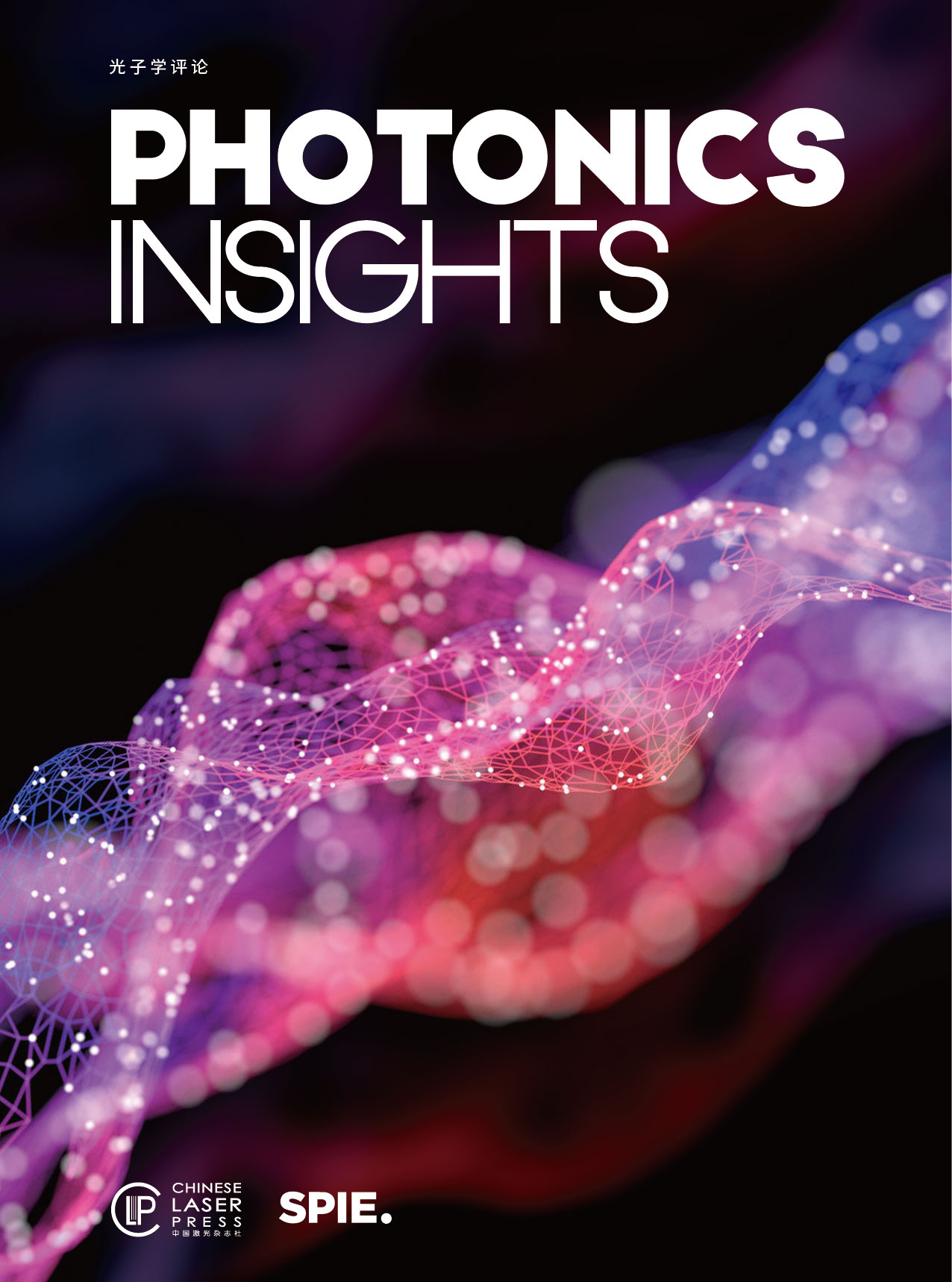Recently, a team led by Prof. Tao Li and Prof. Shining Zhu from Nanjing University was invited by Co-Editors-in-Chief, Prof. Lei Zhou and Prof. Din Ping Tsai, to contribute a comprehensive review paper entitled "Revolutionary meta-imaging: from superlens to metalens", which was published in the Volume 2, Issue 1 of Photonics Insights.
This review systematically illustrates the new principles, new structures and new designs in imaging technology from the perspective of the history of metamaterial development, covering the imaging mechanism and unique functions of superlens, metalens and related derivatives. Especially the revolutionary application scenarios of metalens imaging technology are discussed, and the challenges it faces and the future development directions are prospected. Professor Tanaka from Riken wrote a review article entitled "Metalenses for revolutionary imaging" for this review.
(I) Revolutionary Meta-imaging Technology
Optical lens is the core component of imaging technology. The pursuit of high imaging performance is endless, among which high resolution, large field-of-view, high signal-to-noise ratio and high information throughput have always been important indicators for high imaging performances. In current information era, lightweight and portable imaging systems are attracting more and more attention. However, limited by optical principles, there is a trade-off between the imaging performance of traditional lenses and the integration of devices, such as high resolution and large field-of-view, imaging quality and device complexity, etc. How to break the traditional constraints and realize the revolutionary imaging technology requires innovation in principle.
Metamaterial is a new type of artificial functional material based on the design of micro/nano-structures. Its optical properties are expected to break the limitations of traditional optical materials. For example, Professor Pendry from Imperial College, pointed out that the negative index material (NIM) slab has the ability to break the diffraction limit, which is termed as superlens. However, limited by its harsh working conditions, the siperlens with high performance and massive applications still faces big challenges.
In 2011, Capasso's group from Harvard University proposed the concept of metasurface, which opened up a new direction in the research of optical metamaterials. Among them, metalens has attracted widespread attention because of its ultra-light, ultra-thin and planar architecture. In recent years, the imaging performance of metalens has been significantly improved, but they are still inferior to the traditional lens imaging modules. Therefore, although the metalens has unique advantages in terms of device miniaturization, lightweight and functional flexibility, there are still many challenges to achieve the imaging performance of existing lens group.
From the perspective of metamaterials, this review systematically interprets the working principles, design methods and functional features of three types of flat lenses- superlens, metalens and multilevel diffractive lens. It discusses in detail their advantages and disadvantages respectively, the application scenarios and improvement schemes in imaging applications, and envisions the potential new imaging framework and revolutionary application scenarios.

Fig.1. Two branches of optical lens evolution: Natural materials and Metamaterials (artificial structural material). Among them, metalens and multilevel diffractive lens based on micro nano optics design are expected to bring about revolutionary information technology applications.
(II) Beyond the Limit: Negative Index Material and Super Lens
How to break the diffraction limit of conventional optics has always been the goal of scientists. In 2000, Professor Pendry pointed out that a NIM slab has a function of perfect-lens imaging. The core physics is that the electromagnetic response in NIM can amplify the evanescent wave, which carries the high-frequency information of an object.
Figure 2 shows the wave vector analysis of the electromagnetic wave radiation carrying different structural information on an object surface, where the ultra-small structural information corresponds to a kind of evanescent wave, which will not radiate out and be collected by the optical system. However, the NIM slab superlens can amplify the evanescent wave and recover the super-resolution information of the object.

Fig.2. Schematics of wave-vector space for the relationship between light propagation and structure size.
The principle of the superlens is so wonderful, but how to achieve it? Although the scientist of the former Soviet Union, Veselago proposed the idea of negative refraction at early time, it has been no follow-up implementation. Until Professor Pendry proposed to use subwavelength metal grid and split resonant rings to achieve negative electric and magnetic responses respectively, thereby constructing negative refractive index material. Since then, various schemes have been proposed to realize and demonstrate the negative refractive index material and the functions of superlens. However, limited by the complexity of the structure, material loss and many other challenges, there is still a big gap toward applicable applications.
On the other hand, people have also demonstrated an in-plane negative refraction effect, and shown its flexible dispersion control and metalens function. For example, the Nanjing University research group constructed an in-plane "superlens" subwavelength imaging, which provides a new idea for subwavelength photonic integration. It can be seen that although negative refraction and superlens have not led to massive applications, their revolutionary ideas and design principles are still inspiring the frontiers of photonics research, and may drive new applications such as photonic integration.
(III) New revolution: Metalenses
In 2011, Professor Capasso's group of Harvard University proposed the concept of metasurface, which can also control the wavefront information of light on the subwavelength scale, and derive the generalized Snell's law. The revolutionary idea has greatly enriched the methods for people to control light. After that, people developed metasurface design methods such as resonance phase, geometric phase and propagation phase, and demonstrated various light field control functions, such as angular momentum beams, polarization multiplexing and holograms, etc.
Among them, metalens with focusing phase design have attracted widespread attention due to its ultra-light and ultra-thin, functional diversity and control flexibility. Many researches have focused on the achromatic and aberration properties of metalens for imaging applications. The joint control of multiple phase designs is widely used in achromatic metalens. As for the image aberration, people use phase optimization and double-layer structure schemes. Although the relevant researches have made great progress, there is still a gap between their comprehensive performance and the mature refractive lens group.
From these developments, it can be seen that the main reason restricting the comprehensive performance of metalens is that the subwavelength structural units have limited capability to adjust the space-time dispersion, and it is difficult to fulfill the phase compensation for large size range, large working bandwidth and large field-of-view to obtain excellent comprehensive imaging performance. Designing and developing greater thickness, more layers, using lens arrays and artificial intelligence optimization to increase the parameter space of the metalens are the main solutions to improve the imaging performance of metalens. Figure 3 summarizes the advantages, challenges and possible solutions of metalens in imaging application.

Fig.3. The advantages, challenges and possible solutions of metalens in imaging application.
(IV) Paralleled Strategy: Multilevel Diffractive Lenses
As one of the important applications of wave optics, diffractive optical devices were developed in the 19th century. However, due to problems of high-order diffraction and low work efficiency, they are mainly used for beam shaping rather than imaging. With the advancement of manufacturing technology, "free-form" multilevel diffractive lenses have also been developed, becoming a strong competitor of metalens technology. Figure 4 shows the development process and main features of the diffractive lens.
In recent years, using the height adjustment of the diffraction ring optimized by the algorithm, Professor Menon's group of the Utah University has carried out a series of researches on achromatic multilevel diffractive lens and successfully developed a large-scale achromatic planar diffractive lens. It can be seen as a variation of the metalens. Recently, the Nanjing University research team proposed a new design method and structural optimization scheme, and successfully developed a centimeter-level diameter, ultra-broadband achromatic planar lens with the highest comprehensive performance in the world. In addition, people have begun to introduce algorithms such as artificial intelligence into the development of imaging performance and achieved remarkable results.

Fig.4. The development and performance characteristics of planar diffractive lens.
(V) Application Scenarios of Meta-imaging
Merely from the perspective of imaging performance, these thin and light metalens and diffractive lens still have a significant distance from the existing imaging systems, so where are the disruptive applications they may bring? This issue is not only academia, but also a matter of great concern to the current industry.
In fact, people have developed various new application scenarios by taking advantage of the multi-dimensional light field control of metalens. For example, spectral tomography, spiral phase contrast imaging, large depth-of-field light field imaging, four-dimensional spectral imaging, planar wide-angle imaging, and so on. As well, various highly integrated devices, such as metalens endoscope, meta-microscope, polarization camera, pancake camera, etc. have been developed.
Taking the meta-microscope as an example, the Nanjing University researchers designed a metalens array based on polarization multiplexing to compensate the field of view of the two imaging groups, greatly expanding the field of view of microscopic imaging. Finally, a wide-filed ultra-miniature meta-microscope was developed (see Figure 5). This research greatly increases the portability of the device while improving the performance, which is expected to open up a new technology paradigm for medical diagnosis.
In addition, the metalens technology also shows great potential in compressing the imaging space and improving the performance of AR/VR.

Fig.5. Large field of view meta-microscope constructed by polarization multiplexed metalens array.
Since the new century, we have witnessed the vigorous development of micro/nano photonics and metamaterials, numerous new physical concepts have been proposed, new effects and new principles have been proposed, new functions have been developed, new applications have been discovered. This paper illustrates the development history and mainly features on the superlens to metalens from the perspective of imaging technology, and summarizes the challenges and possible solutions that be faced in the process of moving towards industrial applications.
Where of what's past is prologue. Metalens imaging technology has demonstrated increasingly rich and unique application scenarios. With the continuous enrichment of new design principles, the growing maturity of advanced manufacturing processes, and the continuous incorporation with artificial intelligence, the transformation of imaging technology and industry brought about by meta-photonics is beginning.


